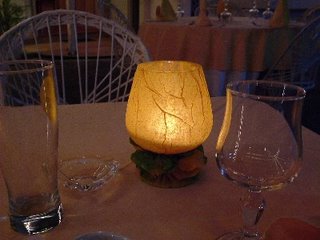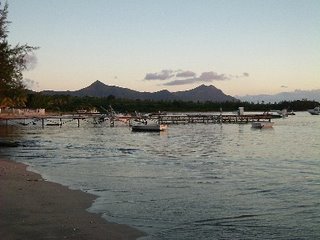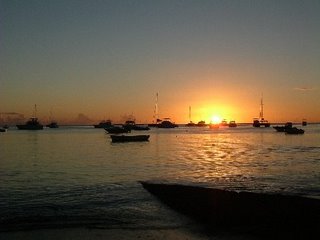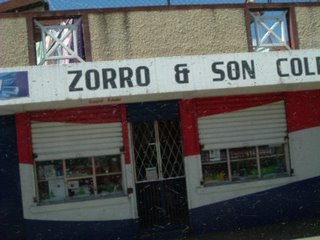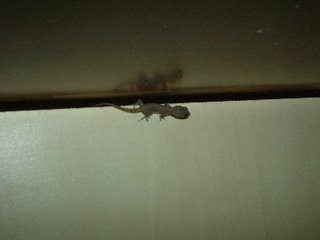Sunday 26th March

The picture above sort of sums up the weather today. Distinctly wet.
Oh yes … Happy Summer-time to all back home! (I assume you did alter the clocks last night?). So now we are separated by a mere three hours; or (N-1) for Dick & Jeanie! (Unless you alter your clocks on a different day? Hmm. never thought of that.)
Today I’m off to the famous botanical gardens at Pamplemousses (I love that name). When I awoke (6.00 am – on a Sunday??) it was raining more fiercely than I have seen it do so far. Now, at almost 8.10 am it has brightened up. The strange thing is I have never heard any thunder or seen any lightening here. It is always just rain by itself. When you see the colour of some of the clouds you think it MUST be a thunderstorm on the way, but no. Just a downpour.
My feet are not as swollen this morning. It seems to build up during the day. I’ve been using a very refreshing peppermint foot spray at night, which helps. This morning though there is a funny sensation under the ball of my right foot – like there is a spongy bit that contacts the floor where normally no contact would be made. It’s a bit hard to describe what I mean. I can’t actually see anything, so I suppose it must be slight residual swelling. You don’t want all this anatomical detail though, I’m sure. Sorry.
Whilst waiting for the driver to arrive at the security gate, I was attempting a conversation with the guard. He is always very pleasant and we exchange a few words every time I go out or come in. He starts on some complicated story about which I pick up only the occasional details – like he lives in Beau Bassin, he has to travel back and forth for work; and something about money. I couldn’t quite grasp what. I suggested he have a word with my driver when he came. This he did. The driver then suggested I get in and he’d explain on the way. First, he enquired as to how well I knew the security guard, and whether I thought he was trustworthy.
I said I had been acquainted with him through passing in and out and exchanging pleasantries. Apparently he doesn’t get paid till next week and can’t afford the journey home (or back here?) so he wanted to know if I would lend him some money. I thought this was very peculiar. We agreed I should not get involved. Surely he would know other people working at the complex – or in the village? It seems strange to ask one of the guests. I’m sort of apprehensive about our next encounter now, in case he asks me again!
Well now we have set off, I realise that I have a correction to make. Later, I find I have a second (as will be explained). The first correction is that we are not going to Pamplemousses after all. A slight mix-up or communication error means he was expecting to take me in the opposite direction to see some of the island's most impressive natural sights. I am not complaining. It suits me fine.
We did a grand tour, which I hope you might be able to make out on the two maps following shortly. I’ve overlaid a rather shaky purple line corresponding roughly to our route. Which was, approximately:
Flic-en-Flac – Quatre Bornes – Vacoas – Floréal – Trou aux Cerfs (volcanic crater) – Mare Aux Vacoas – Grand Bassin (Hindu Temple and “Sacred Lake”) – Black River Gorges – Chamarel (waterfall) – Chamarel (“Coloured Earth”) – Baie du Cap – La Morne Brabant– Petite Rivière Noire – Grande Rivière Noire – Tamarin – Flic-en-Flac.
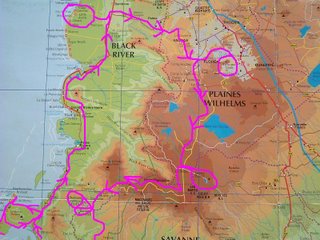
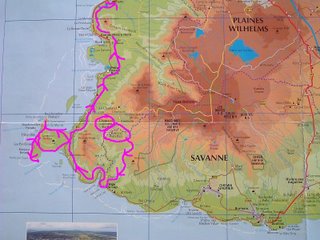
It would be impossible for me to do it justice in words. “Spectacular” is one that tends to get used rather too easily these days, but I think on this occasion it would be well and truly appropriate.
Very soon after we set off the heavens opened, and it was pretty much like that on and off the whole way round. But in a way that added to the dramatic scenery we were to view. And it brings me to my second correction: I can now confirm that Mauritius does indeed experience thunder and lightening. One bolt must have been no more than a hundred metres away from our car. Even so, it was only sporadic – not a fully-fledged thunderstorm (and now I’m confidently anticipating having to correct that remark too at some stage!)
The initial part of our journey takes us through already-familiar territory: Beaux Songes and Palma; but before Quatre Bornes we split off towards Vacoas and
Floréal.
Our first destination is Trou aux Cerfs, near Curepipe. This whole region was once volcanic, and we are at what remains of a long-extinct (we hope!) volcano. Mauritius is geologically one of the oldest islands in the group, but Réunion (neighbouring Mauritius) is much younger and still has an active one.

Looking straight into the crater. Note the lake in the bottom.

One of the splendid views from the crater's edge
What you see here are two mountains. One is called “Les Trois Mamelles” because it consists of three peaks which, presumably, reminded someone of mammals! (Can’t quite see it myself). That one is slightly closer to the camera, and to the left. The other is called Mont Rempart. We see these two from various locations right around the circuit: Mauritius is not very big!
Then on to Mare aux Vacoas. This is one of the island’s largest reservoirs, and is situated right in the centre of the elevated Plaines Wilhelms. One assumes it must in fact be in a dip; or how would the water get there? (Good question, eh?).
There has been rather less rain than usual this past 12 months, but a recent cyclone has almost made up for that. Mare aux Vacoas is now at about 80% capacity. Many of the other reservoirs are full. There isn’t much one can say about the reservoir itself, really. However, the drive up to it was varied; initially taking in the fringes of Curepipe and later a very pretty forested road.
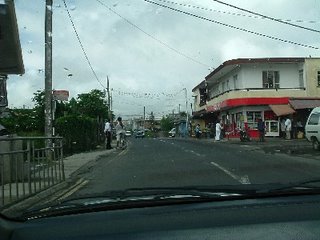
A suburb of Curepipe, on the road to Mare aux Vacoas
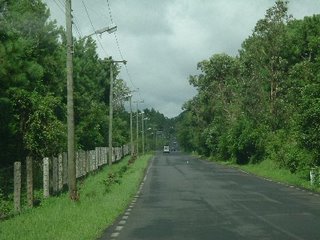
Forested road leading to Mare aux Vacoas

Mare aux Vacoas
From here we head for Grand Bassin, which is not what you might expect from the name. It is in fact a rather small lake. However, its size is not its main attraction. Its true significance lies in the fact that it is perhaps the holiest place of Hindu worship in Mauritius. We are about a mile from Grand Bassin, when Pravin points out a tall feature just visible on the skyline. As we draw closer it resolves into a colossal statue of the Supreme Hindu God, Lord Shiva. Still under construction, it is no doubt the largest representation of Shiva in Mauritius. In this shot you can see Pravin entering the gateway, which should convey some idea of the enormous scale:

Statue of Lord Shiva at Grand Bassin; still under construction
Imagine what it will be like when it has been finished and adorned in its final colours.
Pravin explains to me that Hindus are very religious people. He himself is a devotee of Lord Shiva. He tells me something of the history. Forgive me if I am telling you things you already know. I guess I should have been more aware of this myself. Shiva, the supreme god, is supposedly married to Doorga (also known as Parvati). She protects against evils, as does Shiva himself. They have two sons: the first is Gunesh, who is the God of Wisdom. Hindus will pray to him if, for example, they are embarking upon a new career, or perhaps a course of study. The second son is named Kartikaye and he, like his parents, destroys evils.
Two other gods are also of great importance. Hanuman “protects the yard” according to Pravin; by which, I think he means one’s immediate vicinity. If someone is in a difficult situation, maybe in unfamiliar surroundings, they will call upon Hanuman for assistance. The other very important figure is Ganga, Goddess of Water. The word “ganga” in fact translates as “water”. One can imagine that in the near future she may be called upon with increasing fervour if the many depressing predictions about climate change and global politics come to pass.
The temple and the lakeside are crowded with worshippers. Though we are outside, the air is thick with incense, and many people are in the lake praying. All around the water’s edge lie what, under other circumstances, might be assumed to be discarded food – fruit, bread and other items; but these are offerings to the gods.
There being a strict ban on fishing in the lake the waters are absolutely teeming with small fish, and the occasional not-so-small eel.
Having been raised as a Roman Catholic, but having ultimately rejected most of that faith’s beliefs, I would now describe myself as, at best agnostic; yet there is no doubt that this place has a very special atmosphere.

Worshippers with the god Hanuman
Why this place? Because the original Indian settlers brought with them water from the Ganges which they added to that of the lake at Grand Bassin. One of the holiest days of the year is Maha Shivratree, during which worshippers would traditionally take water from the Ganges back to their local temples, to be placed in the Shivling. This is a shrine to Shiva which contains a partial representation of the god – his throat. Hindu belief has it that a sea was once so poisoned that no fish or plant could live in it. The people implored Lord Shiva to help them, whereupon he took some of the sea water into his mouth, and held it suspended in his throat. Had he swallowed it he himself would have been poisoned. The water taken to the shrine symbolises this event. For Mauritian Hindus, therefore, Grand Bassin is their Ganges.

Ganga, Goddess of Water

Worshippers with Lord Shiva
According to Pravin there are people who claim to have seen fairies at Grand Bassin. Under the circumstances I decide it is wise to resist the temptation to suggest it may have something to do with all the Rhum Arrangé. Instead I express my (genuine) fascination that such stories abound everywhere you go in the world. I cited Irish Leprechauns and Cornish Piskies as examples closer to my own home.
Next on the agenda is Black River Gorges. Apart from the impressive views across the gorge, this part of the trip is marked by our encountering the Norwegian family from “Casa Pizza”. They say it’s a small world. Mauritius is a microscopic country.
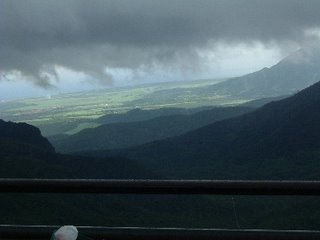
Looking out across Black River Gorges towards the western coastal fringe - where the sun is shining!
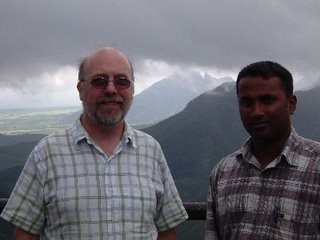
Mike & Pravin at Black River Gorges
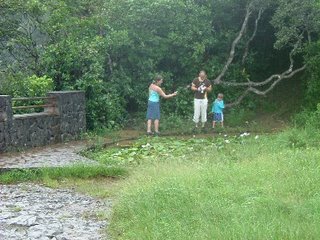
My friends from Norway attempt to photograph frogs at Black River Gorges
And so on to Chamarel, to see the falls and the famous “Coloured Earth”. Both of these attractions lie, according to the LPG: “… in the grounds of a private estate that once belonged to Charles de Chamarel, who entertained Matthew Flinders during Flinders’ captivity in Mauritius during the Napoleonic Wars.” T
There is a small admission charge – Rs60. Pravin observes that it has gone up several times recently, from its original price of around Rs20. No doubt this is merely keeping pace with Mauritius’ newest and fastest-developing industry: tourism
The waterfall is, again, spectacular. In my experience, photos of cataracts rarely come out well when taken by an amateur, especially if that amateur happens to be me; nevertheless, these do give a reasonable impression:


The landscape around here is almost alien. Humps and bumps everywhere, topped mostly by small plantations of juvenile palms, sugarcane, or pineapples (indeed.); and the ubiquitous red soil and mud, running in rivers along the paths and the road itself. It intrigues me that there can still be any of it left to wash away if it rains like this regularly, and has done so for countless millennia.
The Coloured Earth itself is a patch of maybe a few hundred square metres of exposed underlying rock and mud. It is thought to have volcanic origins, and that the different shades of red and brown (officially seven, though there may be more) are a result of the lava having cooled at different rates at different locations. I don’t know enough about geology to agree or otherwise, but here is a glimpse or two:


The rain-gear, by the way, was kindly lent to me by Pravin, who very sensibly waited in the car!
Next stop: Baie du Cap. This is a tiny inlet in the south coast; no less attractive for being small of course. At the tip of the bay the sea water mixes with muddy river water to form a brackish swamp in which mangroves are growing. Now that’s something I had not expected to see.
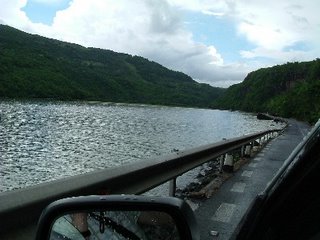
Heading north along the eastern shoreline of Baie du Cap.

Mangroves at the head of Baie du Cap
The ones shown here are just babies. Further round the coast we saw large numbers of mature specimens, their exposed roots forming a sort of “tepee-frame” structure.
And on to La Morne Brabant. It is situated on a miniscule peninsula which marks Mauritius’ most south-westerly point. Like most of the mountains on the island, this eerie lump of rock appears to rise up straight out of the ground. No gentle foot-hills or nursery slopes here; just solid, shear, cliff face. This is a place to which, once, escaped slaves fled to hide from the authorities. These were desperate people. They sheltered in caves, some visible as we drive past; high up on the vertical rock face. From our viewpoint there seems no conceivable way up there, and many of the slaves did indeed perish in the attempt. I asked Pravin what he thought they found in the way of sustenance. He merely shrugged his shoulders.

"La Morne du Brabant" - once a hideout for runaway slaves
Finally, we make our way back along the west coast road, through a number of villages and small towns, passing more mangroves and, on the inland side of the roads, salt pans (at Tamarin).
When we arrive back here I think Pravin deserves a tip. So I offer him Rs1000. That is still less than £20, and given the fantastic trip he took me on, worth every penny. I’m glad, and somewhat relieved, that he is not offended, and willingly takes it. He will, in addition, be receiving over-time pay for today, but I guess that will still not amount to very much.
Rounded off the day with yet another meal at “Casa Pizza”. This time my excuse was I wanted to enquire about booking excursions through them. I find this is indeed possible, so I start to plan a few more trips.
Dinner this evening was fish & aubergine curry followed by Crème Broulet. With, of course, the usual beverages. In fact, the waiter even asked: “The usual, Sir?” So I’ve finally arrived! I have to admit, though that my mind wanders back to those slaves. This “banquet” is something they couldn’t have imagined in their wildest dreams, and it gives me an uneasy feeling of guilt. But that was a long time ago, wasn’t it? Then I recall my journey to Mauritius, and experiencing a similar, though considerably stronger, sensation whilst enjoying a fine Air France Dinner. Some 40,000 feet below us lay The Sudan – one of the most wretched hell-holes on earth.

